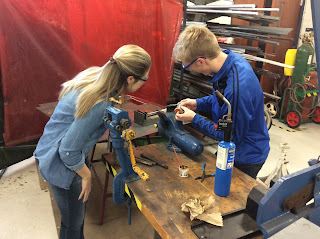The BIG bad TEST
 Announcing there is going to be a "test" to a classroom full of students you are sure to receive many different reactions: I bet there's a student with the look of shear panic across their face, a look of hatred, and maybe if you're lucky a student who doesn't appear to be phased by the announcement. Looking ahead to what my teaching career will look like I want to avoid the panicked and angry expressions of my students as I tell them their will be some sort of evaluation in the class. Evaluating students is one of the most important tasks as an educator but it doesn't mean your students should fear the thought of what they believe the word "test" means. Instead, I have all intentions of reinventing what the word "test" or "evaluation" means. When it comes to teaching in an agricultural classroom, there is so many ways to evaluate your students, often times in ways that don't seem like a "test."
Announcing there is going to be a "test" to a classroom full of students you are sure to receive many different reactions: I bet there's a student with the look of shear panic across their face, a look of hatred, and maybe if you're lucky a student who doesn't appear to be phased by the announcement. Looking ahead to what my teaching career will look like I want to avoid the panicked and angry expressions of my students as I tell them their will be some sort of evaluation in the class. Evaluating students is one of the most important tasks as an educator but it doesn't mean your students should fear the thought of what they believe the word "test" means. Instead, I have all intentions of reinventing what the word "test" or "evaluation" means. When it comes to teaching in an agricultural classroom, there is so many ways to evaluate your students, often times in ways that don't seem like a "test."As an educator I plan to break down the words "test" or "evaluation" for my students right from the start to avoid the previously mentioned feelings.
 Why Evaluated? I want my students to understand I am not evaluating them as some cruel way of torturing them, rather than simply to help them. Evaluation is not just a reflection of the students achievements but also how well I portrayed the information. If the entire class lacks information during an evaluation, there is a good chance that it was my fault. I want my students to understand that I am overall evaluating them to see what information they have retained as well as understand what I need to do better.
Why Evaluated? I want my students to understand I am not evaluating them as some cruel way of torturing them, rather than simply to help them. Evaluation is not just a reflection of the students achievements but also how well I portrayed the information. If the entire class lacks information during an evaluation, there is a good chance that it was my fault. I want my students to understand that I am overall evaluating them to see what information they have retained as well as understand what I need to do better.Students will always known what they need to know. I will always teach based around my unit and lesson objectives, which the students will be reminded on daily. All forms of evaluation will be geared towards the goals of the objectives.
Variability. I will teach a variety of students, which means each students will have their own individual learning styles. It's important to me that each of my students feels comfortable with evaluation. I will strive to provide a variety of different evaluations including; demonstrations, projects, oral, and maybe a few written. Based on the type of evaluation there will be a variety of different grading scales.
 All through school I was that student who had the "shear look of panic" across my face when an upcoming test was announced. The look of panic wasn't because I didn't know the information but because I connected the word test to a long drawn short answer exam. I would sit down to take an exam and often forget all the information that I obtained previously. I never want one of my students to feel that exact same way. In order to change the stigma of what I "test" is I will break down that barrier with a variety of evaluation methods in hopes that each and every one of my students will feel that they can be successful.
All through school I was that student who had the "shear look of panic" across my face when an upcoming test was announced. The look of panic wasn't because I didn't know the information but because I connected the word test to a long drawn short answer exam. I would sit down to take an exam and often forget all the information that I obtained previously. I never want one of my students to feel that exact same way. In order to change the stigma of what I "test" is I will break down that barrier with a variety of evaluation methods in hopes that each and every one of my students will feel that they can be successful.The Agricultural Education Magazine put together a great issue based on evaluation, check it out!
__________________________________________________________________________________________
Newcomb, L.H., McCracken, J.D., Warmbrod, J.R., & Whittington, M.S. (1993). Methods of teaching agriculture. Upper Saddle River, New Jersey: Pearson Prentice Hall.
The Assessment of Teaching and Learning. (July & aug.). The Agricultural Education Magazine, 78(1).


Comments
Post a Comment